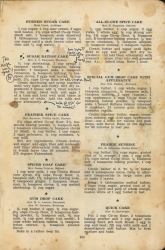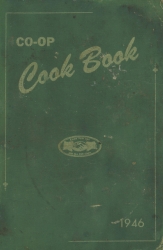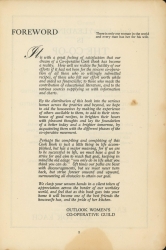
 604 465 4322
604 465 4322General Store Site 12294 Harris Road Pitt Meadows, B.C.
Click Here for Directions& Visiting Hours

Sugar Ration Cake 1946
Recipe
Mrs. A.C. Ferguson, Weyburn
(This recipe was good!!5/5) ½ cup shortening, 1 cup syrup (Corn syrup?? Could use maple syrup or honey),1 teaspoon vanilla, 1 teaspoon baking powder, 1 teaspoon soda, 1 teaspoon cinnamon, ½ teaspoon nutmeg, ¼ teaspoon nutmeg, ¼ teaspoon cloves, 2 eggs well beaten, 2/3 cup milk, 2 1/3 cups Co-op flour (Or all-purpose flour).
Cream shortening and syrup together until very light and fluffy. Sift dry ingredients 3 times; add 1/3 flour mixture to the syrup; blend well; add eggs 1 at a time and beat well until there is no trace of white. Add the milk and flour alternatively. (bake @ 350 degrees for 30 minutes!)
From the Co-Op Cook Book 1946.
*****
Sweet, fragile layers, covered in decadent buttercream frosting and decorated with piped rosettes, represents the delicious treat we all love to indulge in for birthdays, holidays, and other special occasions. Cake has existed for thousands of years, back to ancient civilizations such as Egypt and Rome, and usually contained ingredients like honey, nuts, and dried fruit. When sugar became available in the 17th century, cake recipes incorporated the ingredient to develop lighter, fluffier cakes. With the invention of baking powder and other leavening agents during the 19th century, making cakes at home became more manageable and faster and encouraged production more often. But in the 20th century, many had to restrict making recipes that contained ingredients hard to come by due to two World Wars and the Great Depression affecting many nations. In Canada during the 1940s, the restrictions on food consumption led many Canadians to adjust to new dietary habits. With so few ingredients, rationing encouraged people to make do with less. This sacrifice towards the war effort would prove itself in works such as the Co-Op Cookbook from 1946, which features a recipe called Sugar Ration Cake. This recipe is the epitome of being creative with ingredients at hand while maintaining integrity and purpose towards the effort behind the recipe.
Canada would once again be privy to food rationing. This time, World War II, which started in September 1939, made a more significant impact on the lives of Canadians, mainly with rationing enforced in 1942. Anticipating challenges, the Canadian government implemented a rationing system to ensure goods like food and fuel were distributed fairly. This system used ration books, coupons, and tokens to purchase a fixed amount of goods. Sugar, butter, coffee, tea, meat, canned goods, tires, and gasoline were all essential items susceptible to rationing and were deemed “patriotic” foods. Wartime propaganda included campaigns to promote these foods to strengthen rationing efforts. Often depicted as “weapons of war,” advertisements for food rations continued the cycle of control on the quantity and price of food and the sacrifices people at home were willing to make to support the war. Canada’s significant contributions towards the war effort were paid in blood, with approximately 45,000 Canadian lives lost and many more wounded or taken as war prisoners. Still, those efforts shaped Canada’s identity as a peacekeeping nation.
During the 1940s, Pitt Meadows underwent many changes. With Canada declaring war in 1939, rationing of food was widely felt, extending post-war. With most food items already being rationed, communities had to rely on what was available locally, usually root vegetables. Due to rationing, the Canadian Food Guide was created. Because of the war, Pitt Meadows lost all residents of Japanese descent in 1942 due to the bombing of Pearl Harbour on December 7th, 1941. All residents were placed in internment camps. The Japanese Canadian meeting hall built in 1939 on Advent Road remains the community’s only reminder of Japanese presence. The Pitt Meadows Fire Brigade was created in the same year, with Hans Hoffmann as the first Fire Chief and Ted Ming as Assistant Fire Chief. With volunteers’ help, Hans Hoffman built the Fire Brigade’s first fire truck, maintained by the Pitt Meadows Fire Department and seen yearly in the Pitt Meadows Day parade. In 1944, the Farmer’s Institute completed building its warehouse on the north side of the tracks, on land leased from the CPR. This warehouse provided the members of the Pitt Meadows Farmer’s Institute to purchase supplies in bulk and would later have a hammer mill installed. During this decade, Pitt Meadows also saw many more developments, such as the Blueboy Blueberry Farm, which planted approximately 500 bushes on the old Alouette Peat site, and a new post office (previously in the old general store) run by Robert Thorburn, which was relocated to a spot on McMyn Road. Pitt Meadows also developed a PTA (Parent Teacher Association) chapter in 1944. This decade also saw the paving of Harris Road, which was greatly anticipated. During Harold Sutton’s 18-year position as Reeve, he saw to the water distribution from mains along Lougheed Highway, which would become a reality in 1948, the rebuilding of the lowland area dykes, and paving of most roads. While there were many advancements in Pitt Meadows, this decade also brought great devastation. The Fraser Valley suffered massive flooding during the spring of 1948. Shortly after, a section of the Alouette dyke gave way, with 7000 acres flooding due to the rising rivers and warm weather.
The Co-Op Cookbook offers a recipe, and many others like it, that helped symbolize a difficult time in Canada. Knowing all Canadians were making monumental efforts to aid the war effort, a simple Sugar Ration Cake, which purposefully omits sugar, is a sweet treat needed to understand the complexity and sacrifices during WWII. With challenges and devastation, bloodshed, and devotion, the war effort highlighted the importance of community and standing in solidarity with our country.

Sugar Ration Cake from 1946

Recipe for Sugar Ration Cake from 1946

Co-Op Cook Book 1946

Foreward from the Co-Op Cookbook 1946





